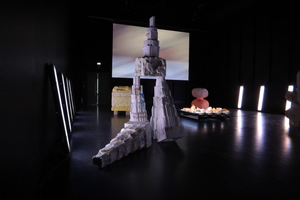an invitation to an exhibition in a laundry
Benachbarte Sets (3)Alle Zusammenhänge anzeigen
Diese Sets wurden den gleichen Sets hinzugefügt wie das ausgewählte Set.
3 Inhalte
- Seite 1 von 1
Bildkompost
- Titel
- Bildkompost
- Autor/in
- Beschreibung (de)
- Über einen Zeitraum von vier Wochen führte Ulf Beck in einer Versuchsanordnung Fotografien aus der Tagespresse einem Kompost mit Kompostwürmern zu. Ausgehend von der Untersuchung, welche Schlagzeilen es auf die erste Seite schaffen sowie deren fotografischer Darstellung, beschäftigte er sich mit dem Nachleben dieser Bilder. Dafür schnitt er jeden Tag die Abbildungen der Titelseite dreier großer Tageszeitungen aus und legte sie in einem Raster auf ein Becken mit Komposterde.
Das fotografische Bild wird als Teil des Medienorganismus durch die Verdauung der Würmer und verschiedener Mikroorganismen innerhalb von ca. 15 Tagen in den Erdorganismus überführt. Der Transformationsprozess ist am Ende nicht mehr sichtbar. Das Bild verliert seine Form und wird zu wertvollem Humus, welcher als Ansammlung von Millionen von Mikrobildern betrachtet werden kann.
- Über einen Zeitraum von vier Wochen führte Ulf Beck in einer Versuchsanordnung Fotografien aus der Tagespresse einem Kompost mit Kompostwürmern zu. Ausgehend von der Untersuchung, welche Schlagzeilen es auf die erste Seite schaffen sowie deren fotografischer Darstellung, beschäftigte er sich mit dem Nachleben dieser Bilder. Dafür schnitt er jeden Tag die Abbildungen der Titelseite dreier großer Tageszeitungen aus und legte sie in einem Raster auf ein Becken mit Komposterde.
- Beschreibung (en)
- Over a period of four weeks, Ulf Beck experimented with composting, using photographs from the daily press with compost worms. Based on the investigation of which headlines make it to the first page and their photographic representation, he deals with the afterlife of these images. For this, every day he cut out the illustrations of the front page of three large daily newspapers and put them in a grid on a basin with compost soil.
The photographic image is transferred as part of the media organism through the digestion of worms and various microorganisms into the earth organism, in around 15 days. The transformation process is no longer visible at the end. The image loses its form and becomes valuable humus, which can be regarded as an accumulation of millions of micro-images.
- Over a period of four weeks, Ulf Beck experimented with composting, using photographs from the daily press with compost worms. Based on the investigation of which headlines make it to the first page and their photographic representation, he deals with the afterlife of these images. For this, every day he cut out the illustrations of the front page of three large daily newspapers and put them in a grid on a basin with compost soil.
- Kategorie
- Typ des Projekts/Werks
- Schlagworte
- Datierung
- 07.12.2017 - 10.12.2017
- Material
- Abmessungen
- variable Maße
- Ort
- Markgrafenstraße 25, 76131 Karlsruhe
- Stadt
- Land
- Beteiligte Institution(en)
- Bemerkungen
- Die Arbeit wird - in veränderter Form - am 27.+28.01.2018 im Rahmen von Plat(t)form 2018, dem zwölften kuratierten internationalen Portfolio-Viewing für junge Künstler aus Europa, im renommierten Fotomuseum Winterthur (CH) zu sehen sein.
- Titel
- Bildkompost
- Projektleiter/in
- Semester
- Studiengang
- Typ der Abschlussarbeit
- Importiert am
- 05.03.2024
- Übergeordnete Sets
- 0
- Set enthält
- 0 11
Future Ruins
- Titel
- Future Ruins
- Titel (en)
- Future Ruins
- Untertitel des Projekts/Werks (en)
- Five Monuments for a Human Planet
- Autor/in
- Beschreibung (de)
- "Future Ruins" besteht aus fünf spekulativen Monumenten. Diese Modelle im menschlichen Maßstab setzen sich mit aktuellen soziologischen und geologischen Entwicklungen, mit den Werten und Idealen unserer Zeit auseinander.
- Beschreibung (en)
- "Future Ruins" consists of five speculative monuments. These human-scaled models are dealing with current sociological and geological developments, the values and ideals of our time.
- Kategorie
- Schlagworte
- Datierung
- 28.-30.06.2019
- Mitwirkende
- Material
- Abmessungen
- verschiedene Maße der Modelle
- Ort: Institution
- Ort
- Großes Studio
- Bemerkungen
- HINWEIS
Es wurden alle Anstrengungen unternommen, um die Urheberrechtsinhaber ausfindig zu machen und ihre Erlaubnis für die Verwendung von urheberrechtlich geschütztem Material einzuholen. Ich entschuldige mich für etwaige Fehler oder Auslassungen und wäre dankbar, wenn mir Korrekturen mitgeteilt würden, die in zukünftige Nachdrucke dieser Dokumentation eingearbeitet werden sollten.
DANKE
HfG Karlsruhe: Sereina Rothenberger, Rebecca Stephany, Michael Kryenbühl, Ivan Weiss, James Langdon, Yannick Nuss, Katharina Wahl, Volker Albus, Matthias Bruhn, Sebastian Schäfer, Alexander Knoppig, Tobias Keilbach, Matthias Mai, Susanne Schmitt, Susanne Trautnitz, Zaur Ahlimanov, Waldemar Schwab
Für die großzügige Unterstützung: Lisa Ertel, Felix Plachtzik, Maxim Weirich, Phil Zumbruch, Lukas Marstaller, Oliver Boualam, Marcel Strauß, Anne-Sophie Oberkrome, Philipp Schell, Christoph Hauf, Christof Hierholzer, Massimiliano Audretsch, Ute Zell, Martin Zell
- HINWEIS
- Titel
- Future Ruins
- Projektleiter/in
- Semester
- Studiengang
- Typ der Abschlussarbeit
- Importiert am
- 31.07.2024
- Übergeordnete Sets
- 0
- Set enthält
- 0 17
Stadt als Sammlung
- Titel
- Stadt als Sammlung
- Autor/in
- Beschreibung (de)
- Das Projekt „Stadt als Sammlung“ ist ein interdisziplinäres Forschungsprojekt, das sich mit den Herausforderungen und Potenzialen des analogen und digitalen Archivierens und Sammelns auseinandersetzt.
- Beschreibung (en)
- The project "Stadt als Sammlung" is an interdisciplinary research project that deals with the challenges and potentials of analog and digital archiving and collecting.
- Kategorie
- Schlagworte
- Mitwirkende
- Ort: Institution
- Ort
- 1. OG, mittlere Lichtbrücke
- Titel
- Stadt als Sammlung
- Projektleiter/in
- Semester
- Studiengang
- Typ der Abschlussarbeit
- Importiert am
- 07.08.2024
- Übergeordnete Sets
- 0
- Set enthält
- 1 5


